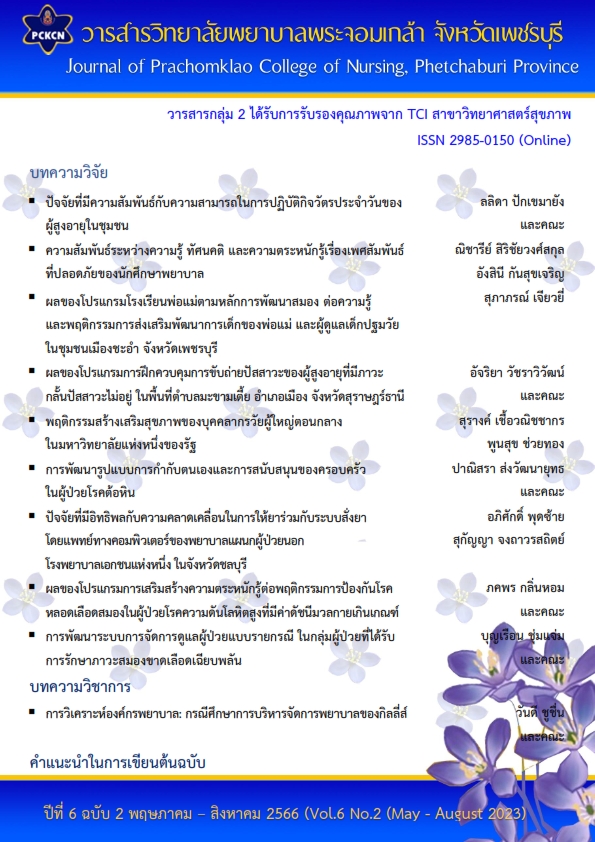การพัฒนารูปแบบการกำกับตนเองและการสนับสนุนของครอบครัวในผู้ป่วยโรคต้อหิน
Main Article Content
บทคัดย่อ
การวิจัยและพัฒนา มีวัตถุประสงค์เพื่อ 1) ศึกษาปัญหาและความต้องการของผู้ป่วยต้อหิน กลุ่มตัวอย่างเป็นผู้ป่วยโรคต้อหิน จำนวน 15 คน เก็บรวบรวมโดยการสนทนากลุ่มย่อย และวิเคราะห์ข้อมูลโดยการวิเคราะห์เนื้อหา 2) พัฒนารูปแบบการกำกับตนเองและการสนับสนุนของครอบครัว และ 3) ประเมินประสิทธิผลรูปแบบที่พัฒนาขึ้น เป็นการวิจัยกึ่งทดลองแบบมีกลุ่มควบคุมวัดก่อน-หลังการทดลอง กลุ่มตัวอย่างเป็นคู่ผู้ป่วยโรคต้อหินและสมาชิกในครอบครัว แบ่งเป็นกลุ่มทดลองและกลุ่มควบคุม กลุ่มละ 58 คู่ เก็บรวบรวมข้อมูลโดยใช้แบบสอบถามพฤติกรรมสุขภาพในผู้ป่วยโรคต้อหินและความสามารถของครอบครัวในการดูแลสุขภาพของผู้ป่วย วิเคราะห์ข้อมูลโดยใช้สถิติพรรณนา และสถิติการทดสอบที ผลการวิจัยพบว่า
1. ผู้ป่วยโรคต้อหินมีปัญหา ได้แก่ 1) ป่วยเป็นโรคต้อหินโดยไม่รู้ตัว เมื่อรู้ก็กลัวตาบอด 2) ผู้ป่วยและครอบครัวไม่เข้าใจการปฏิบัติเกี่ยวกับโรคต้อหิน 3) ควบคุมการดูแลสุขภาพของตนเองไม่ได้และไม่ต่อเนื่อง ในด้านของความต้องการ พบว่า 1) ครอบครัวมาเป็นดวงตา ช่วยดูแลผู้ป่วยและดูแลใจ 2) ความรู้และเทคนิคการกำกับควบคุมตนเอง และ 3) ที่ปรึกษาและผู้ช่วยเหลือเมื่อมีปัญหาการมองเห็นยามฉุกเฉิน
2. รูปแบบการกำกับตนเองและการสนับสนุนของครอบครัวในผู้ป่วยโรคต้อหิน ประกอบด้วยกิจกรรม 4 กิจกรรม ได้แก่ 1) สังเกตและวิเคราะห์พฤติกรรมสุขภาพ กำหนดเป้าหมายและจัดทำแผนกำกับตนเองร่วมกับครอบครัว 2) กำกับ ติดตามผลลัพธ์ตามเป้าหมาย เพื่อการตัดสินใจในการดูแลตนเองต่อเนื่อง 3) เสริมแรงและให้กำลังใจอย่างต่อเนื่องเพื่อสู่เป้าหมาย และ 4) ส่งต่อการดูแลอย่างต่อเนื่อง
3. ประสิทธิผลของการนำรูปแบบไปทดลองใช้พบว่า กลุ่มทดลองมีค่าเฉลี่ยพฤติกรรมสุขภาพในผู้ป่วยโรคต้อหินและความสามารถของครอบครัวในการดูแลสุขภาพของผู้ป่วยโรคต้อหินภายหลังการใช้รูปแบบสูงกว่าก่อนการใช้รูปแบบ (t = 28.19, 28.15 ตามลำดับ) และสูงกว่ากลุ่มควบคุม อย่างมีนัยสำคัญทางสถิติที่ระดับ .01 (t = 26.85, 19.25 ตามลำดับ) และระดับความพึงพอใจอยู่ในระดับดีมาก (M = 4.85, SD = .25)
รูปแบบการกำกับตนเองและการสนับสนุนของครอบครัวในผู้ป่วยโรคต้อหิน ทำให้ผู้ป่วยมีพฤติกรรมสุขภาพที่เหมาะสม สามารถนำไปใช้การดูแลผู้ป่วยโรคต้อหินร่วมกับครอบครัวที่บ้าน
Downloads
Article Details

อนุญาตภายใต้เงื่อนไข Creative Commons Attribution-NonCommercial-NoDerivatives 4.0 International License.
เนื้อหาและข้อมูลที่เผยแพร่ในวารสารวิทยาลัยพยาบาลพระจอมเกล้า จังหวัดเพชรบุรี ถือเป็นข้อคิดเห็นและความรับผิดชอบของผู้นิพนธ์บทความโดยตรง บทความ เนื้อหา ข้อมูล รูปภาพ ฯลฯ ที่ได้รับการเผยแพร่ในวารสารนี้ ถือเป็นลิขสิทธิ์ของวารสารฯ หากบุคคลหรือหน่วยงานใดต้องการนำทั้งหมดหรือส่วนหนึ่งส่วนใดไปเผยแพร่หรือเพื่อกระทำการใด ๆ จะต้องอ้างอิงวิทยาลัยพยาบาลพระจอมเกล้า จังหวัดเพชรบุรี ทุกครั้ง
เอกสารอ้างอิง
Bandura, A. (1986). Social foundations of thought and action: A social cognitive theory. Prentice-Hall.
Faul, F., Erdfelder, E., Lang, A. G., & Buchner, A. (2007). G* Power 3: A flexible statistical power analysis program for the social, behavioral, and biomedical sciences. Behavior Research Methods, 39(2), 175-191.
Fraenkel, A., Lee, G. A., Vincent, S. J., Vincent, R. A., Bourne, R. R., & Shah, P. (2019). Lessons learned from the development and implementation of a patient-reported outcome and experience measure (POEM) in an Australian glaucoma practice. BMC Ophthalmology, 19, Article 192. https://doi.org/10.1186/s12886-019-1198-7
Graneheim, U. H., & Lundman, B. (2004). Qualitative content analysis in nursing research: Concepts, procedures and measures to achieve trustworthiness. Nurse Education Today, 24(2), 105-112.
House, J. S. (1981). Work stress and social support. Addison-Wesley.
Khakai, R., & Dawongsri, P. (2022). The effect of the information-motivation-behavioral skills program on medication adherence elderly glaucoma patients at Udontani Hospital. Udonthani Hospital Medical Journal, 30(3), 421-434. (in Thai)
Kitsripisarn, S., & Pankasikorn, P. (2019). Glaucoma patients’ adherence to therapy: Qualitative research. Journal of Thailand Nursing and Midwifery Council, 34(4), 19-33. (in Thai)
Lemeshow, S., Hosmer, D. W., Klar, J., Lwanga, S. K., & World Health Organization. (1990). Adequacy of sample size in health studies. Wiley.
Lim, N., Fan, C. H., Yong, M. K., Wong, E. P., & Yip, L. W. (2016). Assessment of depression, anxiety, and quality of life in Singaporean patients with glaucoma. Journal of Glaucoma, 25(7), 605-612.
Nastasi, B. K., & Schensul, S. L. (2005). Contributions of qualitative research to the validity of intervention research. Journal of School Psychology, 43(3), 177-195.
Phrachomklao Hospital, Phetchaburi Province. (2021). Statistical data of glaucoma patients. Phrachomklao Hospital, Phetchaburi Province. (in Thai)
Poorat, J., Pichayapinyo, P., & Lagampan, S. (2020). Effects of self-regulation program on glycemic control in patients with uncontrolled type 2 diabetes. Kuakarun Journal of Nursing, 27(1), 20-33. (in Thai)
Pornvichitpisan, S., Kajornchaikul, P., & Buriprasert, C. (2018). Understanding of eye drop use in glaucoma outpatients of King Chulalongkorn Memorial Hospital. Chulalongkorn Medical Journal, 62(2), 187-95. (in Thai)
Songwatthannayuth, S., Savatsuwa, B., & Nongnouch, S. (2019). Effects of a family nursing intervention based on the Illness Believe model on ability of health behavior in post operation of cataract patients and ability of health behavior of their families with cataract patients. Boromarajonani College of Nursing, Uttaradit Journal, 1(2), 16-31. (in Thai)
Sriphon, P. (2018). Prevalence of vision loss in glaucoma. Chaiyaphum Medical Journal, 38(2), 46-55. (in Thai)
Suksanan, P., Bchobtrong, S., & Pranprawit, A. (2016). Effects of a weight reduction program with application of self-regulations and social support among village health volunteers. The Southern College Network Journal of Nursing and Public Health, 3(1), 46-59. (in Thai)
Suratako, R., Silpasuwan, P., Satitvipawee, P., & Kitnarong, N. (2014). The effect of self-care behavior promotion program for intraocular pressure control among the elderly with glaucoma. Siriraj Nursing Journal, 7(2), 16-60. (in Thai)
Wanitbancha, K. (2016). Statistical analysis: Statistics for administration and research. (16th ed.). Printing House of Chulalongkorn University. (in Thai)


